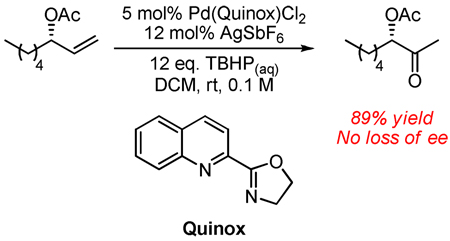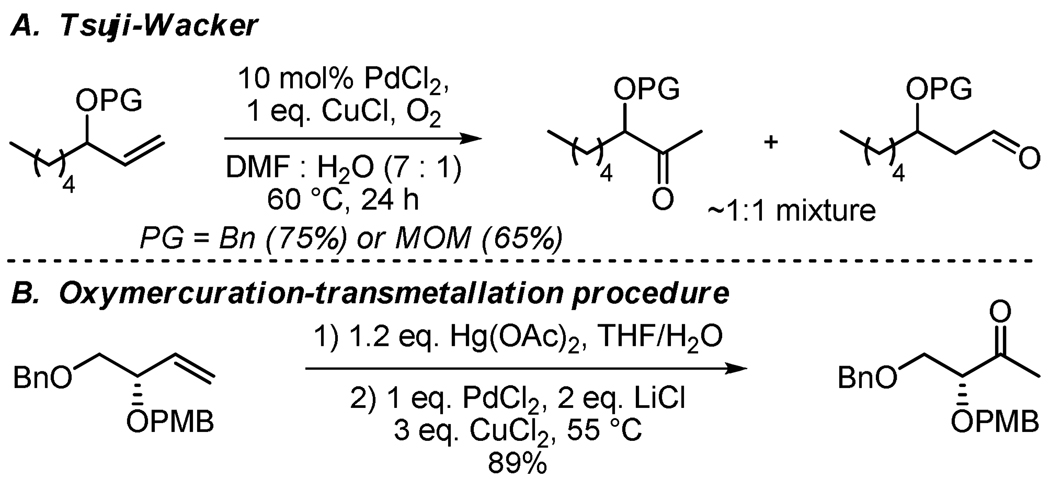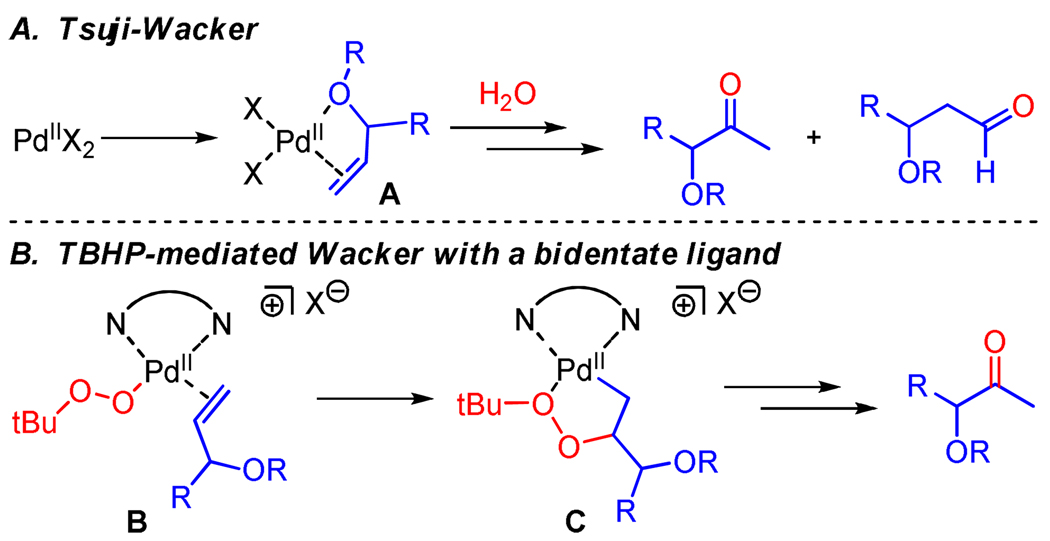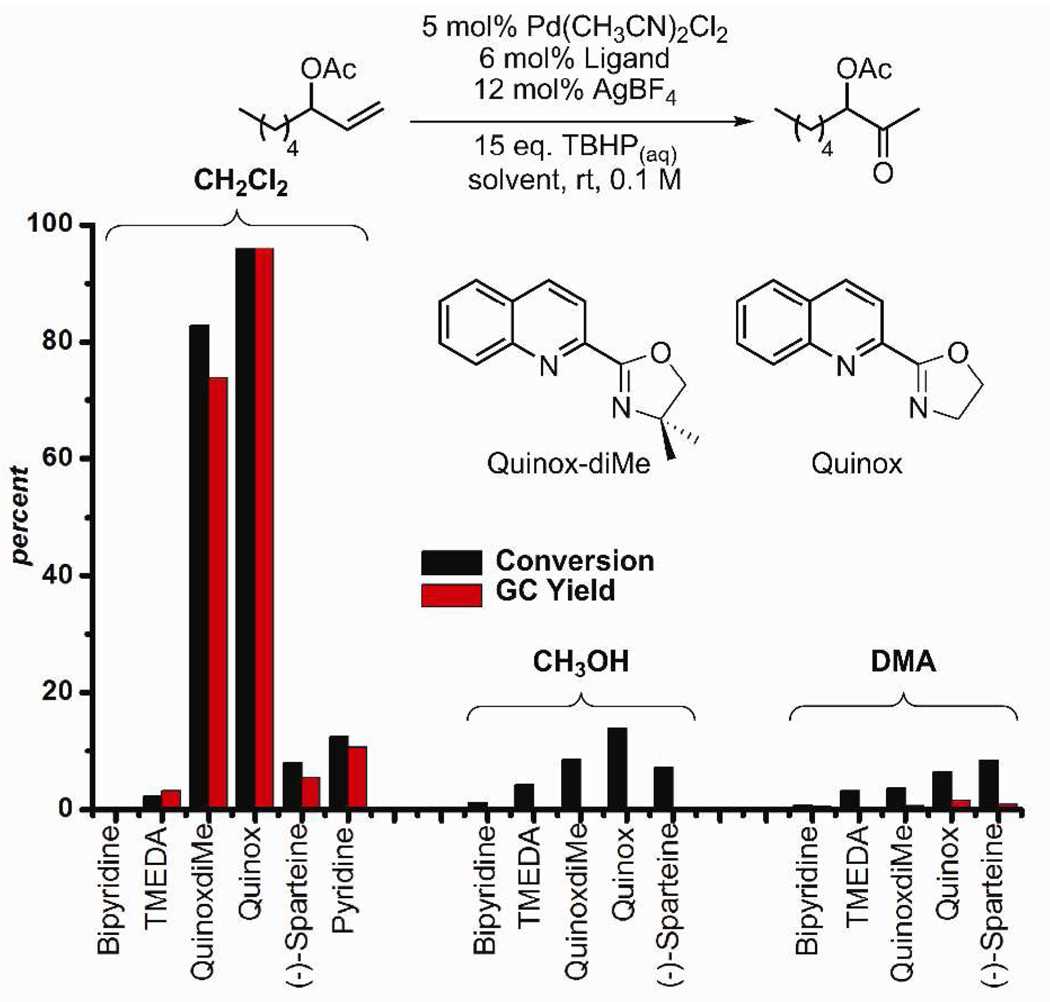Abstract
Utilizing the rapidly synthesized Quinox ligand and commercially available aqueous TBHP, a Wacker-type oxidation has been developed, which efficiently converts the traditionally challenging substrate class of protected allylic alcohols to the corresponding acyloin products. Additionally, the catalytic system is general for several other substrate classes, converting terminal olefins to methyl ketones, with short reaction times. The system is scalable (20 mmol) and can be performed with a reduced catalyst loading of 1 mol%. Enantioenriched substrates undergo oxidation with complete retention of enantiomeric excess.
The Tsuji-Wacker oxidation, the palladium-catalyzed conversion of a terminal olefin to a methyl ketone, has widespread synthetic applications, owing to an extensive substrate scope and the orthogonal reactivity of olefins and ketones.1 However, a major limitation in the scope is for allylic alcohols and their protected variants.2 Oxidation of theses substrates would yield a high utility acyloin product, which is an attractive synthon for asymmetric synthesis.3 Previous reports of Wacker oxidations on protected allylic alcohols using Tsuji-type conditions found diminished selectivity for the desired methyl ketone.4 This is highlighted by the results observed by Kang and coworkers, who obtained methyl ketone and aldehyde in an inseparable 1:1 mixture (Figure 1A).4a The current approach to accessing the methyl ketone products from allylic alcohols is a two-step procedure, which generally utilizes stoichiometric amounts of mercury, palladium, and copper (Figure 1B).5 Although this procedure allows for access to acyloin products in good yields, the high metal loadings, resulting in toxic byproducts, hardly make this an attractive procedure. Herein we report a highly efficient Wacker-type oxidation system capable of converting protected allylic alcohols to acyloins and various terminal alkenes to methyl ketones using low catalyst loadings, mild conditions, and aqueous 70 wt.% TBHP (T-Hydro®) as the terminal oxidant.
Figure 1.
(A) Poor selectivity for protected allylic alcohols under Tsuji-Wacker conditions and (B) two step oxymercuration-transmetallation for selective oxidation of protected allylic alcohols.
The problematic nature of protected allylic alcohols in Wacker oxidations has been proposed to arise from coordination of the oxygen atom to the Lewis acidic palladium as in complex A (Scheme 1A).2 This can cause water to attack through multiple pathways, resulting in both the Markovnikov and anti-Markovnikov products (Scheme 1A). We hypothesized that the selectivity issue can be mitigated by ligand modulation in conjunction with a TBHP-mediated Wacker-type oxidation, which is proposed to proceed via a pathway mechanistically distinct from the classical Wacker oxidation.6 Specifically, the use of a bidentate ligand, with TBHP, on palladium is thought to lead to a coordinatively saturated species similar to B, which can block allylic oxygen atom coordination. Consequently, insertion would be directed to the Markovnikov position yielding species C, which decomposes to yield the methyl ketone product.6
Scheme 1.
(A) Proposed coordination of protected allylic alcohols and (B) our hypothesis for TBHP-mediated Wacker-type reaction utilizing a bidentate ligand to block coordination of oxygen atom.
To explore this idea, a number of ligands, which have found success in Pd-catalyzed oxidation reactions,7 as well as other common bidentate amine ligands, were evaluated in solvents common for Wacker-type processes (Figure 3). Pyridine was also evaluated as a potential ligand in CH2Cl2, as Uemura and co-workers have had success with pyridine as a ligand in a proposed Pd based Wacker-type oxidation.8 Of the ligands evaluated, only reactions using the quinoline-2-oxazoline (Quinox) framework showed significant product formation. These achiral ligands have not been utilized in Pd-catalyzed oxidation reactions to the best of our knowledge. It should also be noted that CH2Cl2 as the solvent is particularly well suited to this chemistry in contrast to our previous work with TBHP-mediated Wacker oxidations, which utilizes methanol.9 With a viable ligand class and solvent selected, the reaction parameters were optimized wherein it was found that the use of SbF6 − as the counterion gives the best rate of reaction and selectivity for the methyl ketone product.10
Using these conditions, the substrate scope was evaluated. Several common protecting groups for allylic alcohols were shown to be compatible with these conditions, providing the methyl ketone products in high yields (Table 1, entries 1–4). It should be noted that no aldehyde product was detected in any of these cases by GC or 1H NMR analysis. Additionally, silyl protected allylic alcohols proceed to product at a significantly faster rate, allowing for the use of lower catalyst loadings (entry 2). An acetal-protecting group, analogous to the MOM group of Figure 1A, was stable to Lewis acidic, aqueous reaction conditions (entry 3). A homoallylic alcohol also was converted to the methyl ketone in excellent yield (entry 5). It should be noted that benzyl and PMB protecting groups lead to a mixture of oxidation products and are therefore not currently compatible with this methodology.
Table 1.
Substrate scope.
 | ||||
|---|---|---|---|---|
| Entry | Substrate | x | % Yielda | Time |
 |
||||
| 1b | PG = Ac | 5 | 89 | 20 h |
| 2c | PG = TBS | 2 | 77 | 4.5 h |
| 3d | PG = CH2OCH2CH3 | 5 | 81 | 4 h |
| 4b | 5 | 89 | 17 h | |
| 5d | 2 | 92 | 35 min | |
| 6 | R = C8H17 | 2 | 86 | 20 min |
| 7e | R = C8H17 | 2 | 75 | 4 h |
| 8 | R = HOC9H18 | 2 | 98 | 35 min |
| 9f | R = HOC9H18 | 1 | 91 | 40 min |
| 10 | R = MeO2CC8H16 | 2 | 87 | 35 min |
| 11 |  |
2 | 95 | 30 min |
| 12d | R = ClC9H18 | 2 | 89 | 80 min |
| 13 | R = 4-MePh | 5 | 88 | 50 min |
| 14d | R = 4-BOCNHPh | 5 | 83 | 60 min |
| 15d | R = 3-NO2Ph | 5 | 60 | 17 h |
Average isolated yield of two experiments performed on 3 mmol scale.
Substrate added at room temperature.
15 mol% AgSbF6 used.
1 mmol scale.
4 eq. TBHP used.
One experiment performed on 20 mmol scale and at 0.2 M.
The catalytic system was further evaluated to determine whether it was a general catalyst for the Wacker oxidation. In our previous work on TBHP-mediated Wacker-type oxidations, we found that simple alkenes undergo facile isomerization leading to internal olefin and ketone isomers.1c Excitingly, the current system rapidly consumes decene leading to 2-decanone in good yield with no appreciable amounts of internal isomers (entry 6). Lowering the amount of TBHP led to conversion of decene without significant loss of yield or increase in isomerization (entry 7). Other functional groups were evaluated including an alkene with a free distal alcohol, which was used to demonstrate the scalability of the reaction using a reduced catalyst loading (entries 8 & 9). Additionally, alkenes containing common functional groups including a methyl ester, acetonide, and primary chloride, are well tolerated (entries 10–12).11 A number of styrene derivatives, another challenging substrate class for the Tsuji-Wacker oxidation,2 were also evaluated. Substituted styrenes with various functional groups were efficiently oxidized, although a highly electron deficient system led to a lower yield and a trace amount of m-nitro benzaldehyde (entries 13–15).12 It should be noted that these reactions are exothermic, therefore the oxidations were initiated at 0 °C. Finally, to ascertain the applicability of this method to target synthesis, enantioenriched protected allylic and homoallylic alcohols were oxidized under the optimal conditions with no loss of enantiomeric excess (eq. 1 & eq 2).
 |
(1) |
 |
(2) |
In conclusion, we have discovered a practical general method for the Wacker oxidation, which exhibits short reaction times, uses an inexpensive oxidant, can tolerate previously challenging substrates, and provides products selectively in high yields. Of particular interest is the exceptional performance of the Quinox ligand, which is rapidly synthesized in two steps,13 as compared with the other bidentate nitrogen ligands evaluated. An exciting aspect of this development is that the ligand framework is highly modular, which will facilitate future mechanistic analysis of this observation. This work and other synthetic applications including the development of an enantioselective variant are underway.
Supplementary Material
Experimental procedures and characterization data for new substances. This material is available free of charge via the Internet at http://pubs.acs.org.
Figure 2.
Evaluation of bidentate ligands and solvent.
Acknowledgement
This work was supported by the National Institutes of Health (NIGMS RO1 GM63540). M.S.S. thanks the Dreyfus Foundation and Pfizer for their support. A.M.C. thanks the NSF-REU program (CHE-0649039). We are grateful to Johnson Matthey for the gift of various Pd salts.
Notes and References
- 1.For a recent review of Wacker oxidations, see: Takacs JM, Jiang X-t. Curr. Org. Chem. 2003;7:369–396. ; (b) Tsuji J. Synthesis. 1984:369–384. [Google Scholar]; (c) Cornell CN, Sigman MS. Inorg. Chem. 2007;46:1903–1909. doi: 10.1021/ic061858d. [DOI] [PubMed] [Google Scholar]
- 2.Muzart J. Tetrahedron. 2007;63:7505–7521. [Google Scholar]
- 3.Reetz MT. Angew. Chem., Int. Ed. Engl. 1984;23:556–569. [Google Scholar]
- 4.(a) Kang S-K, Jung K-Y, Chung J-U, Namkoong E-Y, Kim T-H. J. Org. Chem. 1995;60:4678–4679. [Google Scholar]; (b) Hamad O, Henry PM, Thompson C. J. Org. Chem. 1999;64:7745–7750. [Google Scholar]
- 5.For examples: Hunt DF, Rodeheaver GT. J. Chem. Soc. Chem. Comm. 1971:818–819. ; (b) Crimmins MT, Brown BH. J. Am. Chem. Soc. 2004;126:10264–10266. doi: 10.1021/ja046574b. [DOI] [PubMed] [Google Scholar]; (c) Nicolaou KC, Xu JY, Kim S, Pfefferkorn J, Ohshima T, Vourloumis D, Hosokawa S. J. Am. Chem. Soc. 1998;120:8661–8673. [Google Scholar]
- 6.(a) Mimoun H, Charpentier R, Mitschler A, Fischer J, Weiss R. J. Am. Chem. Soc. 1980;102:1047–1054. [Google Scholar]; (b) Cornell CN, Sigman MS. J. Am. Chem. Soc. 2005;127:2796–2797. doi: 10.1021/ja043203m. [DOI] [PMC free article] [PubMed] [Google Scholar]
- 7.For examples, see: Sigman MS, Jensen DR. Acc. Chem. Res. 2006;39:221–229. doi: 10.1021/ar040243m. ; Zhang Y, Sigman MS. J. Am. Chem. Soc. 2007;129:3076–3077. doi: 10.1021/ja070263u. [DOI] [PubMed] [Google Scholar]
- 8.Nishimura T, Kakiuchi N, Onoue T, Ohe K, Uemura S. J. Chem. Soc., Perkin Trans. 2000;1:1915–1918. [Google Scholar]
- 9.Cornell CN, Sigman MS. Org. Lett. 2006;8:4117–4120. doi: 10.1021/ol061662h. [DOI] [PubMed] [Google Scholar]
- 10.See supporting information for details. SbF6 > PF6 > OTf ≈ BF4.
- 11.As per reviewer suggestion, we have submitted a hindered terminal alkene, 1-ethenyladamantane, to our reaction conditions yielding (94% by GC in 15 min) only the methyl ketone product as determined by GC and 1H NMR.
- 12.The aldehyde product is the result of oxidative cleavage of the alkene.
- 13.See supporting information for details.
Associated Data
This section collects any data citations, data availability statements, or supplementary materials included in this article.
Supplementary Materials
Experimental procedures and characterization data for new substances. This material is available free of charge via the Internet at http://pubs.acs.org.






